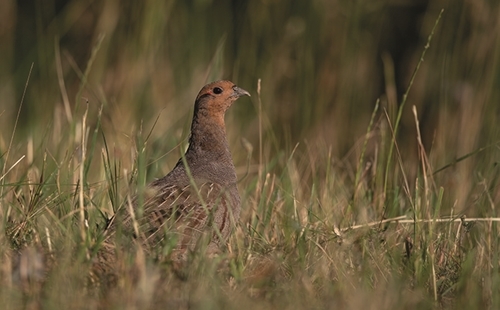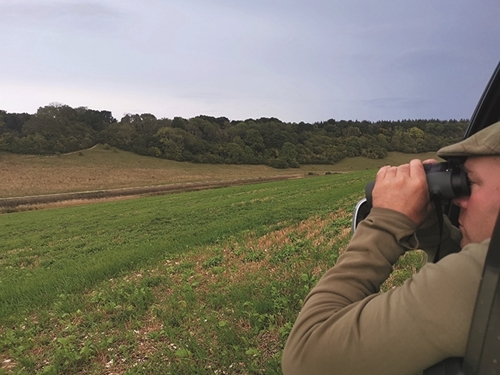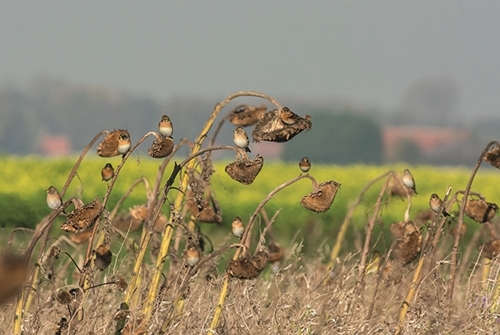
Photo Credit: Helge Sorensen
Neville Kingdon looks at our historic Partridge Count Scheme and how the future of the iconic grey partridge rests in the hands of individuals on the ground
Once one of the most familiar birds of the countryside, grey partridges have declined in the last 30 years. The grey partridge is one of the best indicators of farmland ecosystem health; where they thrive, biodiversity is high and ecosystem services remain intact. In areas where few or no partridges exist, the farm environment is typically much degraded.
We believe that the future of the grey partridge rests in the hands of individuals on the ground through the management measures that they can implement. Our Partridge Count Scheme, which is celebrating its 90th Anniversary, is a free and voluntary scheme run by the GWCT since 1933 to collect information on the annual abundance and breeding success of grey partridges.
One of the longest-running surveys of its kind, the PCS relies on the participation of volunteer farmers, gamekeepers and land managers, to gather data on pair counts in spring and counts of young and old birds in the autumn. It represents a unique example of citizen science in action.

The Count Scheme launched in the early 1930s. Major HG Eley (who established the ICI Game Research Station – the forerunner of the GWCT) funded research (through ICI because of its interest in cartridge production) into partridge ecology at the fledgling, yet ground-breaking, Bureau of Animal Population at Oxford University run by Charles Elton, the ‘Father’ of animal ecology. In 1932 Doug Middleton, who played a large part in building up the early ‘Bureau’ with Elton, turned his attention to game research. He organised a system of censuses and fieldwork, visiting major partridge estates by motorcycle, setting up the PCS as a basis to study the grey partridge. In 1937 Middleton left Oxford, to become director of the ICI Game Research Station, bringing his nascent PCS with him.
Shaped by Elton and the Bureau, Middleton’s work combined natural history and fieldwork with measuring and modelling population processes. His papers were some of the first to examine gamebird ecology and laid the foundations for grey partridge research. Long before post-WW2 agricultural intensification, Middleton’s early papers discussed factors holding back grey partridge numbers that we still battle today. These include the need for greater provision of nesting and brood-rearing habitats, chick food availability, the importance of overwinter cover, predation pressure at key life stages, the effects of weather and modernisation of farming methods.
In its original form, from 1933 to 1998, the PCS collated data from around one hundred shooting estates. This comprised counts of spring pairs and autumn broods, providing an overview of grey partridge numbers across the UK’s shooting estates. This included calculations of young-to-old/chick survival rates, to look at summer chick production and overwinter survival.

Photo Credit: Jannie Timmer
Biodiversity Action Plan species
In 1998 the PCS became central to the GWCT’s response as the lead partner for the grey partridge under the UK Government’s Biodiversity Action Plan (BAP). The PCS was expanded to engage with members of the broader farming community who were sympathetic to conserving partridges, but perhaps not as a game species.
This expansion led to an increase in the number of PCS counts undertaken per year from 84 in the spring of 1998 to 855 in 2012. PCS participants recorded an increase in grey partridge breeding density from the early 2000s to 2012. Many contributors utilised the new Environmental Stewardship Schemes (especially the Higher-Level Scheme, available from 2005) that supported new beetle banks, hedgerows, conservation headlands and wild bird cover.
As part of the GWCT’s effort as the BAP lead partner for grey partridge, our advisors provided practical support and management advice to farmers and landowners to help them achieve their share of the national BAP target, utilising ocal groups throughout the country and with the help of the GWCT demonstration project at Royston. The PCS was used as a tool by its participants to monitor progress and make timely adjustments where needed. For a few years it was possible to address those factors that Middleton identified in the 1930s. Then the cold, wet June of 2012 resulted in low productivity across the country. Afterwards, partridge numbers stabilised but have since failed to increase.
The success some PCS participants have had since, in recovering grey partridge numbers, indicates that it is still possible to increase grey partridge numbers, but it is not easy. We hope that the new Environmental Land Management scheme (ELMs) will be sufficiently supported, providing the necessary funding for farmers and landowners. This should promote and expand the habitat management that we know addresses the need for nesting cover, chick-food and overwinter food and cover identified by Middleton 90 years ago. Defra stated in 2022 that ELMs will fund predation management, alongside habitat options, for projects that aim to restore red-listed groundnesting farmland birds. We hope to hear more detail on this in 2023, but research, much led by the GWCT, has shown that what is good for the grey partridge is good for other farmland birds, insects, mammals and plants.
Join the Partridge Count Scheme
We are looking for more farmers, land managers and gamekeepers who are interested in helping conserve their grey partridges to join the PCS, count their partridges and submit their findings to us. There are no restrictions on how few partridges you must have to start with, nor must you have an interest in them as a quarry species. People on the ground hold the key to the conservation of the grey partridge and so much more. PCS contributors have stepped up to this challenge. The grey partridge needs others to join them in this endeavour.
Go to the PCS